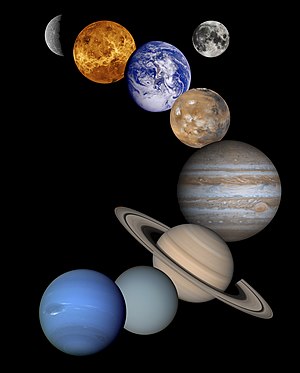I attended a concert last Saturday night by the
National Symphony Orchestra. The name of the concert was
The Planets in HD. It featured the suite by Gustav Holst which he called
The Planets--one song for each planet (he skipped Earth and Pluto hadn't been declared a planet yet at that point, and it no longer is a planet so the point is now moot). While the orchestra was playing the music, they had up on the big screen pictures from NASA including some computer animations, but mostly it was images that they have collected. It was quite interesting. I was impressed with the detail that some of the images had. And, of course, I love the music.
 Image via Wikipedia
Image via Wikipedia Image via Wikipedia
Image via Wikipedia
That is interesting. I've never heard of this piece before. Now I would really like to hear this in person myself. Thanks for the heads up Keith.
ReplyDelete(I still would like to know what music would sound like with an irrational time signature. Say sqrt(3)/4 time. :))
Joseph,
ReplyDeleteI'm surprised you don't realize that conductors continually use irrational time signatures. Since there are an infinity of infinities of irrational numbers between each integer and given the fact that the human mechanics involved are imprecise, an orchestra will phase in an out of several irrational time signatures during a given performance.
Nothing beats Blue Danube in pi/4 =:)
Yeah, the irrational numbers are sort of dense :).
ReplyDeleteUuggh, confusing time signature with tempo. The idiot has left the building, carry on! =:)
ReplyDeleteNow, this is something that I've given much thought to, being a math nerd. Leave the irrational time signature aside and just stick with funny rational numbers like 4/5. See, the notation system for music allows for any dyadic rational note value to be written (although you rarely see a denominator larger than 64). Therefore, while it would be possible to create a fifth note, it would take literally an infinite number of notes all tied together, which would definitely make the music harder to read.
ReplyDeleteOf course, the same thing would happen if you tried pi/4. While it would be easy enough to get quarter notes, getting exactly pi of them in the same measure would require the same sort of infinite series. However, even a pure nerd like me now has to admit that at this point music would start to lose its beauty and become far too technical.
Keith,
ReplyDeleteThat's interesting. It may not sound igood, but if you only needed a countably infinite number of notes (perhaps for the wired rational signature you describe) in theory you could list all of the notes using a formula and therefore compose a song right? If that is the case, I still would like to hear such a song whether it sounds good or not just to hear it.
This is the song that never ends, yes it goes on and on my friend. Some people....
Of course you only need countably many, because as you said the dyadics are dense. In fact, you're not just limited to dyadics because you can use triplets and get fractions of the form 1/(2^n*3) as well. So, 2/3 or 3/3 time wouldn't be very difficult, nor would 8/6.
ReplyDeleteWhile the score may look quite impressive, if you were to devise such a system, I doubt it would make the music much richer. See, the problem is that your eardrums aren't very sensitive, so they're not going to be able to tell much of a difference between say, for example, a fifth note (with the infinite series of dyadics it would require) and a dotted eighth note, which is not too uncommon in music. It has value .1875 instead of the requested .2, but the difference, which is .0125=1/80 is so negligible that you wouldn't perceive it. Especially, considering as Stan pointed out that most of the musicians playing aren't going to give the note exactly a .1875 value anyway, it would be just somewhere between .15 and .2.
Great stuff Keith!
ReplyDeleteTell you what, Joe. You write the music having an irrational key signature, and I'll write the adaptive noise cancelling filter to filter it all out ;-).
ReplyDelete